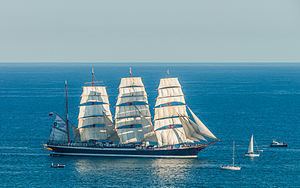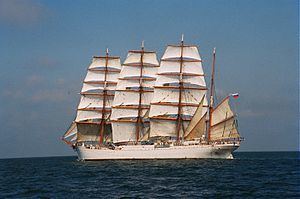Ordered 1919 Commissioned 1921 Construction started 1920 Length 117 m | Laid down 1920 Name Setov Launched 1921 Beam 15 m | |
 | ||
Name Magdalene Vinnen II (1921–1936)Kommodore Johnsen (1938–1948) Builder | ||
STS Sedov (Russian: Седов), formerly Magdalene Vinnen II (1921–1936) and Kommodore Johnsen (–1948), is a four-masted steel barque that for almost 80 years was the largest traditional sailing ship in operation. Originally built as a German cargo ship, Sedov is today a sail training vessel, training cadets from the universities of Murmansk, Saint Petersburg and Arkhangelsk. She participates regularly in the big maritime international events as a privileged host and has also been a regular participant in The Tall Ships' Races.
Contents
Magdalene Vinnen II

Sedov, originally named Magdalene Vinnen II, was launched at Kiel, Germany in 1921 by the Friedrich Krupp Germaniawerft for the shipping company F. A. Vinnen & Co. of Bremen, one of the largest German shipping companies at the beginning of the 20th century. The shipping company initially objected to have an engine installed in the ship, but the ship yard (with backing from a Government committee) successfully argued for an engine, making the ship the first sailing ship with auxiliary engine designed to modern principles.

Magdalene Vinnen II was at the time the world’s largest auxiliary barque and exclusively used as a cargo ship with a crew that was partially made up of cadets. She sailed on her maiden voyage on 1 September 1921. Her voyage took her from Bremen via Cardiff, where she took on coal, to Buenos Aires. Despite bad weather, the journey from England to Argentina with holds full of coal took just 30 days. Magdalene Vinnen II carried all sorts of cargo: apart from coal, she took timber from Finland, wheat from Australia, pyrite from Italy and unit load from Belgium. The four-masted barque made two voyages around Cape Horn to Chile. Until her last voyage as Magdalene Vinnen II in 1936, the ship sailed to Argentina, South Africa, Australia, Reunion and the Seychelles.
Kommodore Johnsen
On 9 August 1936, Magdalene Vinnen II was sold to Norddeutscher Lloyd of Bremen and renamed Kommodore Johnsen. The new owner modified her to a cargo-carrying training ship. More accommodation was provided, as the ship, apart from her permanent crew, was to have a complement of 50 to 60 trainee officers on each journey.
Sedov

She came under Russian state ownership after the surrender of Germany — on 20 December 1945, the British handed over the ship to the Soviet Union as war reparation. In the Soviet Union, she was converted into a sail training vessel of the Soviet Navy. Renamed Sedov after the Arctic explorer Georgy Sedov who died during an investigation in the Arctic in 1914, she was used as a training ship of the Navy from 1952 to 1957. She made several friendly visits to South America and Africa during this period. From 1957 to 1966 she was used as an oceanographic research ship in the North Atlantic. During these voyages, the Soviet Navy also used her for training of young cadets. In 1966 when she was transferred to the reserve in Kronstadt, formally under the civil ownership of the Ministry of Fisheries. In the 1970s, she was only infrequently used as a training ship, sailing in the Gulf of Finland.
In 1981, Sedov reappeared after renovation which had new features added such as a glass-domed banquet hall with a stage and a movie theater. She was now based at the Baltic Division of Training Ships in Riga. She embarked cadets from schools of navigation of Kaliningrad and Murmansk. After the declaration of independence of Latvia in 1991, she left Riga for Murmansk, transferred to the Murmansk naval school with the city of Murmansk ensuring her management and maintenance.
Sedov has regularly been targeted by unpaid creditors of the Russian Federation such as Nissim Gaon (of now defunct Swiss group NOGA, an anagram of Gaon) and also by French holders of defaulted Russian bonds; in 2002 Sedov was forced to precipitously and unexpectedly leave Marseilles in the dead of night to avoid being served a writ by AFPER (French association of holders of Russian Empire bonds) the following morning.
For over a year French holders of defaulted Russian bonds were warning they were going to reorganize and export their claim to Anglo-Saxon jurisdictions, more friendly to private citizens than the French.
In May 2008, in the wake of British-Russian tension, Sedov was instructed by Moscow not to dock as planned at Southend-on-Sea. The September 2008 visit to Falmouth, the starting point of FUNCHAL 500 race to Madeira, also seemed to be in jeopardy.
In 2011 Sedov celebrated her 90th anniversary. In 2012 Sedov started her first voyage around the world of more than 13 months. The voyage ended on 20 July 2013 at Saint Petersburg, Russia.
